In this paper we propose to argue for two claims. The first is that a sizeable group of epistemological projects – a group which includes much of what has been done in epistemology in the analytic tradition – would be seriously undermined if one or more of a cluster of empirical hypotheses about epistemic intuitions turns out to be true. The basis for this claim will be set out in Section 2. The second claim is that, while the jury is still out, there is now a substantial body of evidence suggesting that some of those empirical hypotheses are true. Much of this evidence derives from an ongoing series of experimental studies of epistemic intuitions that we have been conducting. A preliminary report on these studies will be presented in Section 3. In light of these studies, we think it is incumbent on those who pursue the epistemological projects in question to either explain why the truth of the hypotheses does not undermine their projects, or to say why, in light of the evidence we will present, they nonetheless assume that the hypotheses are false. In Section 4, which is devoted to Objections and Replies, we’ll consider some of the ways in which defenders of the projects we are criticizing might reply to our challenge. Our goal, in all of this, is not to offer a conclusive argument demonstrating that the epistemological projects we will be criticizing are untenable. Rather, our aim is to shift the burden of argument. For far too long, epistemologists who rely heavily on epistemic intuitions have proceeded as though they could simply ignore the empirical hypotheses we will set out. We will be well satisfied if we succeed in making a plausible case for the claim that this approach is no longer acceptable.
To start, it will be useful to sketch a brief – and perhaps somewhat idiosyncratic
– taxonomy of epistemological projects. With
the aid of this taxonomy we will try to “locate in philosophical space”
(as Wilfrid Sellars used to say) those epistemological projects which,
we maintain, are threatened by the evidence we will present. There are
at least four distinct, though related, projects that have occupied the
attention of epistemologists. Following
Richard Samuels,[1]
we’ll call them the Normative Project, the Descriptive Project, the Evaluative
Project and the Ameliorative Project.
The
Normative Project, which we’re inclined to think is the most philosophically
central of the four, attempts to establish norms to guide our epistemic efforts. Some of these norms may
be explicitly regulative, specifying which ways of going about the quest
for knowledge should be pursued and which should not. This
articulation of regulative norms is one of the more venerable of philosophical
undertakings, going back at least to Descartes’ Regulae and evident
in the work of Mill, Popper and many other important figures in the history
of philosophy; and it continues in philosophy today. For
example, when Alvin Goldman chastises internalism for being unable to provide
us with “Doxastic Decision Principles,” he is challenging the ability of
internalism to pull its weight in this aspect of the Normative Project.[2]The
Normative Project also aims to articulate what might be called valuational
norms, which attempt to answer questions like: What
is our epistemic good? and How
should we prefer to structure our doxastic lives? One may not be able to
generate regulative principles from the answers provided; rather, the answers
tell us at what target the regulative principles should aim.
The Descriptive Project can have a variety of targets, the two most common being epistemic concepts and epistemic language. When concepts are the target, the goal is to describe (or “analyze”) the epistemic concepts that some group of people actually invoke. When pursued by epistemologists (rather than linguists or anthropologists), the group in question is typically characterized rather vaguely by using the first person plural. They are “our” concepts, the ones that “we” use. Work in this tradition has led to a large literature attempting to analyze concepts like knowledge, justification, warrant, and rationality.[3]When language is the focus of the Descriptive project, the goal is to describe the way some group of people use epistemic language or to analyze the meaning of their epistemic terms. Here again, the group is almost invariably “us”.
Many
epistemologists think that there are important links between the Normative
and Descriptive Projects. Indeed,
we suspect that these (putative) links go a long way toward explaining
why philosophers think the Descriptive Project is so important. In
epistemology, knowledge is “the good stuff” and to call a belief an instance
of knowledge is to pay it one of the highest compliments an epistemologist
can bestow.[4]Thus
terms like ‘knowledge,’ ‘justification,’ ‘warrant’ etc. and the concepts
they express are themselves plausibly regarded as implicitly normative. Moreover,
many philosophers hold that sentences invoking epistemic terms have explicitly
normative consequences. So, for example,
‘S’s belief that p is an instance of knowledge’ might plausibly be taken
to entail ‘Ceteris paribus, S ought to believe that p’ or perhaps
‘Ceteris paribus, it is a good thing for S to believe that p’.[5]For
reasons that will emerge, we are more than a bit skeptical about the alleged
links between the Descriptive and Normative Projects. For the time being,
however, we will leave the claim that the two projects are connected unchallenged.
The
Evaluative Project tries to assess how well or poorly people’s actual belief
forming practices accord with the norms specified in the Normative Project. To
do this, of course, another sort of descriptive effort is required. Before
we can say how well or poorly people are doing at the business of belief
formation and revision, we have to say in some detail how they actually
go about the process of belief formation and revision.[6]The
Ameliorative Project presupposes that we don’t all come out with the highest
possible score in the assessment produced by the Evaluative Project, and
asks how we can improve the way we go about the business of belief formation. In
this paper our primary focus will be on the Normative Project and on versions
of the Descriptive Project which assume that the Descriptive and Normative
Projects are linked in something like the way sketched above.
The
family we have in mind belongs to a larger group of strategies which (just
to be provocative) we propose to call Epistemic Romanticism. One
central idea of 19th century Romanticism was that our real selves, the
essence of our identity, is implanted within us, and that to discover who
we really are we need but let that real identity emerge. Epistemic
Romanticism assumes something rather similar about epistemic norms. According
to Epistemic Romanticism, knowledge of the correct epistemic norms (or
information that can lead to knowledge of the correct norms) is implanted
within us in some way, and with the proper process of self–exploration
we can discover them. As we read
him, Plato was an early exponent of this kind of Romanticism about matters
normative (and about much else besides). So
Epistemic
Platonism might be another (perhaps equally provocative) label for
this group of strategies for discovering or testing epistemic norms.
(i)
The strategy must take epistemic intuitions as data or input. (It
can also exploit various other sorts of data.)
(ii)
It must produce, as output, explicitly or implicitly normative claims or
principles about matters epistemic. Explicitly normative claims include
regulative claims about how we ought to go about the business of belief
formation, claims about the relative merits of various strategies for belief
formation, and evaluative claims about the merits of various epistemic
situations. Implicitly normative claims include claims to the effect that
one or another process of belief formation leads to justified beliefs or
to real knowledge or that a doxastic structure of a certain kind amounts
to real knowledge.
(iii)
The output of the strategy must depend, in part, on the epistemic intuitions
it takes as input.If provided with
significantly different intuitions, the strategy must yield significantly
different output.[7]
Perhaps
the most familiar examples of Intuition Driven Romanticism are various
versions of the reflective equilibrium strategy in which (to paraphrase
Goodman slightly) “a [normative] rule is amended if it yields an inference
we are [intuitively] unwilling to accept [and] an inference is rejected
if it violates a [normative] rule we are [intuitively] unwilling to amend.”[8]In
a much discussed paper called “Can Human Irrationality Be Experimentally
Demonstrated,” L. J. Cohen proposes a variation on Goodman’s strategy as
a way of determining what counts as rational or normatively appropriate
reasoning.[9]It
is of some importance to note that there are many way in which the general
idea of a reflective equilibrium process can be spelled out. Some
philosophers, including Cohen, advocate a “narrow” reflective equilibrium
strategy. Others advocate a “wide”
reflective equilibrium strategy. And
both of these alternatives can be elaborated in various ways.[10]Moreover,
the details are often quite important since different versions of the reflective
equilibrium strategy may yield different outputs, even when provided with
exactly the same input.
Another
example of the IDR strategy can be found in Alvin Goldman’s important and
influential book, Epistemology and Cognition (1986). A
central goal of epistemology, Goldman argues, is to develop a theory that
will specify which of our beliefs are epistemically justified and which
are not, and a fundamental step in constructing such a theory will be to
articulate a system of rules or principles evaluating the justificatory
status of beliefs. These rule, which
Goldman calls J-rules, will specify permissible ways in which cognitive
agents may go about the business of forming or updating their beliefs .They
“permit or prohibit beliefs, directly or indirectly, as a function of some
states, relations, or processes of the cognizer.”[11] But,
of course, different theorists may urge different and incompatible sets
of J-rules. So in order to decide
whether a proposed system of J-rules is correct, we must appeal to a higher
criterion – Goldman calls it “a criterion of rightness” – which will specify
a “set of conditions that are necessary and sufficient for a set of J-rules
to be right.”[12]But
now the theoretical disputes emerge at a higher level, for different theorists
have suggested very different criteria of rightness.Indeed,
as Goldman notes, an illuminating taxonomy of epistemological theories
can be generated by classifying them on the basis of the sort of criterion
of rightness they endorse. So how
are we to go about deciding among these various criteria of rightness? The
answer, Goldman maintains, is that the correct criterion of rightness is
the one that comports with the conception of justification that is “embraced
by everyday thought and language.”[13]To
test a criterion, we consider the judgments it would entail about specific
cases, and we test these judgments against our “pretheoretic intuition.” “A
criterion is supported to the extent that implied judgments accord with
such intuitions and weakened to the extent that they do not.”[14],[15]
The
examples we have mentioned so far are hardly the only examples of Intuition
Driven Romanticism. Indeed, we think a plausible case can be made that
a fair amount of what goes on in normative epistemology can be classified
as Intuition Driven Romanticism. Moreover,
to the extent that it is assumed to have normative implications, much of
what has been written in descriptive epistemology in recent decades also
counts as Intuition Driven Romanticism. For
example, just about all of the vast literature that arose in response to
Gettier’s classic paper uses intuitions about specific cases to test proposed
analyses of the concept of knowledge.[16]
For
many purposes, the details of an IDR strategy – the specific ways in which
it draws inferences from intuitions and other data – will be of enormous
importance.But since our goal is
to raise a problem for all IDR strategies, the exact details of how they
work will play no role in our argument.Thus,
for our purposes, an IDR strategy can be viewed as a “black box” which
takes intuitions (and perhaps other data) as input and produces implicitly
or explicitly normative claims as output.The
challenge we are about to raise is, we claim, a problem for IDR accounts
no matter what goes on within the black box.
2.2.The
Normativity Problem
Reflective
equilibrium strategies and other Intuition Driven Romantic strategies all
yield as outputs claims that putatively have normative force. These
outputs tell us how people ought to go about forming and revising their
beliefs, which belief forming strategies yield genuinely justified beliefs,
which beliefs are warranted, which count as real knowledge rather than
mere opinion, etc. But there is a
problem lurking here – we’ll call it the Normativity Problem: What
reason is there to think that the output of one or another of these Intuition
Driven Romantic strategies has real (as opposed to putative) normative
force? Why should we care about
the normative pronouncements produced by these strategies? Why
should we try to do what these outputs claim we ought to do in matters
epistemic? Why, in short, should
we take any of this stuff seriously?
We
don’t think that there is any good solution to the Normativity Problem
for Intuition Driven Romanticism or indeed for any other version of Romanticism
in epistemology .And because there
is no solution to the Normativity Problem, we think that the entire tradition
of Epistemic Romanticism has been a very bad idea. These,
obviously, are very big claims and this is not the place to mount a detailed
argument for all of them. We do, however, want to rehearse one consideration,
first raised in Stich’s book, The Fragmentation of Reason.[17]We
think it lends some plausibility to the claim that satisfying solutions
to the Normativity Problem for Intuition Driven Romanticism are going to
be hard to find. It will also help
to motivate the empirical studies we will recount in the section to follow.
What
Stich noted is that the following situation seems perfectly possible. There
might be a group of people who reason and form beliefs in ways that are
significantly different from the way we do. Moreover,
these people might also have epistemic intuitions that are significantly
different from ours. More specifically,
they might have epistemic intuitions which, when plugged into your favorite
Intuition Driven Romantic black box yield the conclusion that their
strategies of reasoning and belief formation lead to epistemic states that
are rational (or justified, or of the sort that yield genuine knowledge
– pick your favorite normative epistemic notion here). If
this is right, then it looks like the IDR strategy for answering normative
epistemic questions might sanction any of a wide variety of regulative
and valuational norms. And that sounds like bad news for an advocate of
the IDR strategy, since the strategy doesn’t tell us what we really want
to know. It doesn’t tell us how we should go about the business of forming
and revising our beliefs. One might,
of course, insist that the normative principles that should be followed
are the ones that are generated when we put our intuitions into
the IDR black box. But it is less
than obvious (to put it mildly) how this move could be defended. Why
should we privilege our intuitions rather than the intuitions of some other
group?
One
objection that was occasionally raised in response to this challenge focused
on the fact that the groups conjured in Stich’s argument are just philosophical
fictions.[18]While
it may well be logically possible that there are groups of people whose
reasoning patterns and epistemic intuitions differ systematically from
our own, there is no reason to suppose that it is nomologically or psychologically
possible. And without some reason
to think that such people are psychologically possible, the objection continued,
the thought experiment does not poses a problem that the defender of the
IDR strategy needs to take seriously. We
are far from convinced by this objection, though we are prepared to concede
that the use of nomologically or psychologically impossible cases in normative
epistemology raises some deep and difficult issues. Thus,
for argument’s sake, we are prepared to concede that a plausible case might
be made for privileging normative claims based on actual intuitions over
normative claims based on intuitions that are merely logically possible. But
what if the people imagined in the thought experiment are not just logically
possible, but psychologically possible? Indeed,
what if they are not merely psychologically possible but real – and to
all appearances normal and flourishing? Under
those circumstances, we maintain, it is hard to see how advocates of an
IDR strategy can maintain that their intuitions have any special standing
or that the normative principles these intuitions generate when plugged
into their favorite IDR black box should be privileged over the normative
principles that would be generated if we plugged the other people’s intuitions
into the same IDR black box. In
the section to follow we will argue that these “what ifs” are not just
“what ifs”. There really are people
– normal, flourishing people – whose epistemic intuition are systematically
different from “ours”.
3.Cultural
Variation in Epistemic Intuitions
3.1.Nisbett
and Haidt:Some Suggestive Evidence
Our
suspicion that people like those imagined in Stich’s thought experiment
might actually exist was first provoked by the results of two recent research
programs in psychology. In one of these, Richard Nisbett and his collaborators
have shown that there are large and systematic differences between East
Asians and Westerners[19]
on a long list of basic cognitive processes including perception, attention
and memory. These groups also differ
in the way they go about describing, predicting and explaining events,
in the way they categorize objects and in the way they revise beliefs in
the face of new arguments and evidence. This
work makes it very plausible that the first part of Stich’s thought experiment
is more than just a logical possibility. There
really are people whose reasoning and belief forming strategies are very
different from ours. Indeed, there
are over a billion of them!
Though
space does not permit us to offer a detailed account of the differences
that Nisbett and his colleagues found, a few brief notes will be useful
in motivating the studies we will describe later is this section. According
to Nisbett and his colleagues, the differences “can be loosely grouped
together under the heading of holistic vs. analytic thought.” Holistic
thought, which predominates among East Asians, is characterized as “involving
an orientation to the context or field as a whole, including attention
to relationships between a focal object and the field, and a preference
for explaining and predicting events on the basis of such relationships.” Analytic
thought, the prevailing pattern among Westerners, is characterized as “involving
detachment of the object from its context, a tendency to focus on attributes
of the object in order to assign it to categories, and a preference for
using rules about the categories to explain and predict the object’s behavior.”[20]One
concomitant of East Asian holistic thought is the tendency to focus on
chronological rather than causal patterns in describing and recalling events. Westerners,
by contrast, focus on causal patterns in these tasks.[21]Westerners
also have a stronger sense of agency and independence, while East Asians
have a much stronger commitment to social harmony. In
East Asian society, the individual feels “very much a part of a large and
complex social organism … where behavioral prescriptions must be followed
and role obligations adhered to scrupulously.”[22]
The
second research program that led us to suspect there might actually be
people like those in Stich’s thought experiment was the work Jonathan Haidt
and his collaborators.[23]These
investigators were interested in exploring the extent to which moral intuitions
about events in which no one is harmed track judgments about disgust in
people from different cultural and socioeconomic groups. For
their study they constructed a set of brief stories about victimless activities
that were intended to trigger the emotion of disgust. They
presented these stories to subjects using a structured interview technique
designed to determine whether the subjects found the activities described
to be disgusting and also to elicit the subjects’ moral intuitions about
the activities. As an illustration,
here is a story describing actions which people in all the groups studied
found (not surprisingly) to be quite disgusting:
A
man goes to the supermarket once a week and buys a dead chicken. But
before cooking the chicken, he has sexual intercourse with it. Then
he cooks it and eats it.
The
interviews were administered to both high and low socioeconomic status
(SES) subjects in Philadelphia (USA) and in two cities in Brazil. Perhaps
the most surprising finding in this study was that there are large differences
in moral intuitions between social classes. Indeed,
in most cases the difference between social classes was significantly greater
than the difference between Brazilian and American subjects of the same
SES.Of course we haven’t yet told
you what the differences in moral intuitions were, though you should be
able to predict them by noting your own moral intuitions. (Hint:If
you are reading this article, you count as high-SES.)Not
to keep you in suspense, low SES subjects tend to think that the man who
has sex with the chicken is doing something that is seriously morally wrong;
high SES subjects don’t. Much the
same pattern was found with the other scenarios used in the study.
3.2.Four
Hypotheses
For
our purposes, Haidt’s work, like Nisbett’s, is only suggestive. Nisbett
gives us reason to think that people in different cultural groups exploit
very different belief forming strategies. Haidt’s
work demonstrates that people in different SES groups have systematically
different moral intuitions. Neither investigator explored the possibility
that there might be differences in epistemic intuitions in different
groups. However, the results they
reported were enough to convince us that the following pair of hypotheses
might
be true, and that it was worth the effort to find out:
Hypothesis
1:Epistemic
intuitions vary from culture to culture.
Hypothesis
2:Epistemic
intuitions vary from one socioeconomic group to another.
Hypothesis
4:
Epistemic intuitions depend, in part, on the order in which cases are presented.
Moreover,
it might well be the case that some of the results of order effects are
very hard to modify.[25]
If
any one of these four hypotheses turns out to be true then, we maintain,
it will pose a serious problem for the advocate of Intuition Driven Romanticism. If
all of them are true, then it is hard to believe that any plausible case
can be made for the claim that the normative pronouncements of Intuition
Driven Romanticism have real normative force – that they are norms that
we (or anyone else) should take seriously.
3.3.Some
Experiments Exploring Cultural Variation in Epistemic Intuitions
Are any
of these hypotheses true? To try
to find out we have been conducting a series of experiments designed to
test Hypotheses 1 and 2.While the
results we have so far are preliminary, they are sufficient, we think,
to at least shift the burden of argument well over in the direction of
the defender of IDR strategies. What
our results show, we believe, is that the advocates of IDR can no longer
simply ignore these hypotheses or dismiss them as implausible, for there
is a growing body of evidence which suggests that they might well be true.
In
designing our experiments, we were guided by three rather different considerations.
First, we wanted our intuition probes – the cases that we would ask subjects
to judge – to be similar to cases that have actually been used in the recent
literature in epistemology. Second,
since the findings reported by Nisbett and his colleagues all focused on
differences between East Asians (henceforth EAs) and European Americans
(henceforth Ws, for “Westerners”), we decided that would be the obvious
place to look first for differences in epistemic intuitions. Third,
since Nisbett and his colleagues argue that Ws are significantly more individualistic
than EAs, who tend to be much more interdependent and “collectivist” and
thus much more concerned about community harmony and consensus, we tried
to construct some intuition probes that would tap into this difference. Would
individualistic Ws, perhaps, be more inclined to attribute knowledge to
people whose beliefs are reliably formed by processes that no one else
in their community shares. The answer,
it seems, is yes.
3.3.1.Truetemp
Cases
An
issue of great moment in recent analytic epistemology is the internalism/externalism
debate. Internalism, with respect to some epistemically evaluative property,
is the view that only factors within an agent’s introspective grasp
can be relevant to whether the agent’s beliefs have that property. Components
of an agent’s doxastic situation available to introspection are internalistically
kosher; other factors beyond the scope of introspection, such as the reliability
of the psychological mechanisms that actually produced the belief, are
epistemically external to the agent. Inspired
by Lehrer (1990), we included in our surveys a number of cases designed
to explore externalist/internalist dimensions of our subjects’ intuitions. Here
is one of the questions we presented to our subjects, all of whom were
undergraduates at Rutgers University.[26]
One
day Charles is suddenly knocked out by a falling rock, and his brain becomes
re–wired so that he is always absolutely right whenever he estimates the
temperature where he is. Charles is completely unaware that his brain has
been altered in this way. A few weeks later, this brain re–wiring leads
him to believe that it is 71 degrees in his room. Apart from his estimation,
he has no other reasons to think that it is 71 degrees. In fact, it is
at that time 71 degrees in his room. Does Charles really know that it was
71 degrees in the room, or does he only believe it?
REALLY KNOWS ONLY
BELIEVES
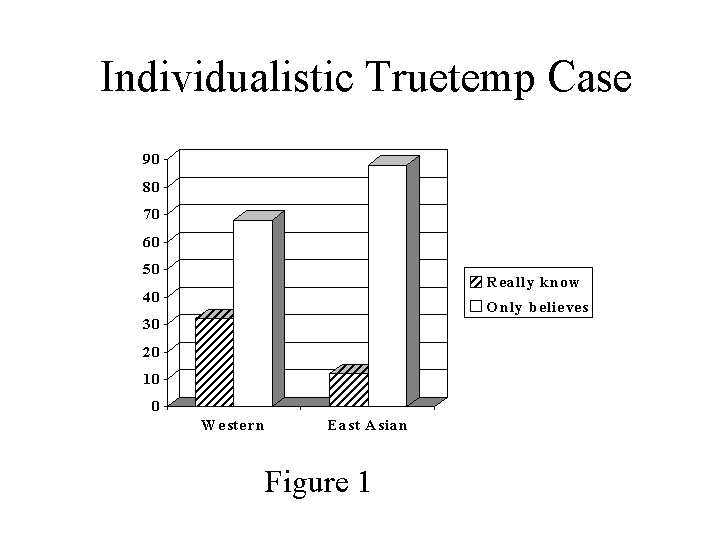
After
finding this highly significant difference, we began tinkering with the
text to see if we could construct other “Truetemp” cases in which the difference
between the two groups would disappear.Our
first thought was to replace the rock with some socially sanctioned intervention.The
text we used was as follows:
One
day John is suddenly knocked out by a team of well–meaning scientists sent
by the elders of his community, and his brain is re–wired so that he is
always absolutely right whenever he estimates the temperature where he
is. John is completely unaware that his brain has been altered in this
way. A few weeks later, this brain re–wiring leads him to believe that
it is 71 degrees in his room. Apart from his estimation, he has no other
reasons to think that it is 71 degrees. In fact, it is at that time 71
degrees in his room. Does John really know that it was 71 degrees in the
room, or does he only believe it?
REALLY KNOWS ONLY
BELIEVES
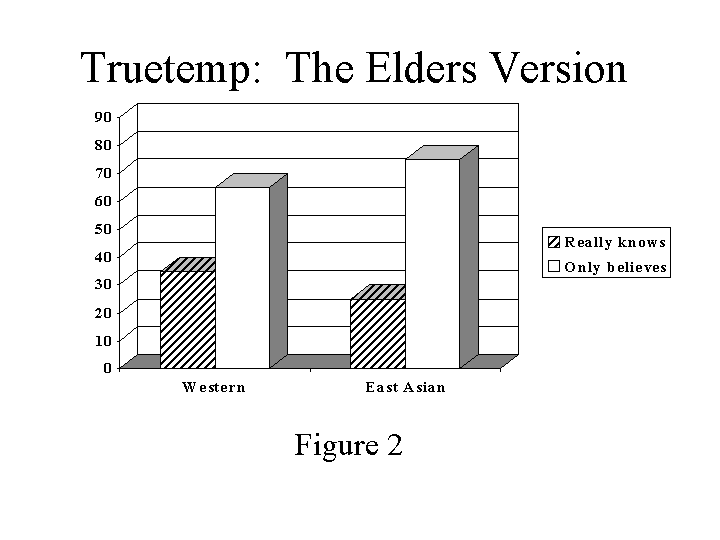
Encouraged
by this finding we constructed yet another version of the “Truetemp” case
in which the mechanism that reliably leads to a true belief is not unique
to a single individual, but rather is shared by everyone else in the community.
The intuition probe read as follows:
The
Faluki are a large but tight knit community living on a remote island.
One day, a radioactive meteor strikes the island and has one significant
effect on the Faluki – it changes the chemical make–up of their brains
so that they are always absolutely right whenever they estimate the temperature.
The Faluki are completely unaware that their brains have been altered in
this way. Kal is a member of the
Faluki community. A few weeks after
the meteor strike, while Kal is walking along the beach, the changes in
his brain lead him to believe that it is 71 degrees where he is. Apart
from his estimation, he has no other reasons to think that it is 71 degrees. In
fact, it is at that time exactly 71 degrees where Kal is.Does
Kal really know that it is 71 degrees, or does he only believe it?
REALLY KNOWS ONLY
BELIEVES
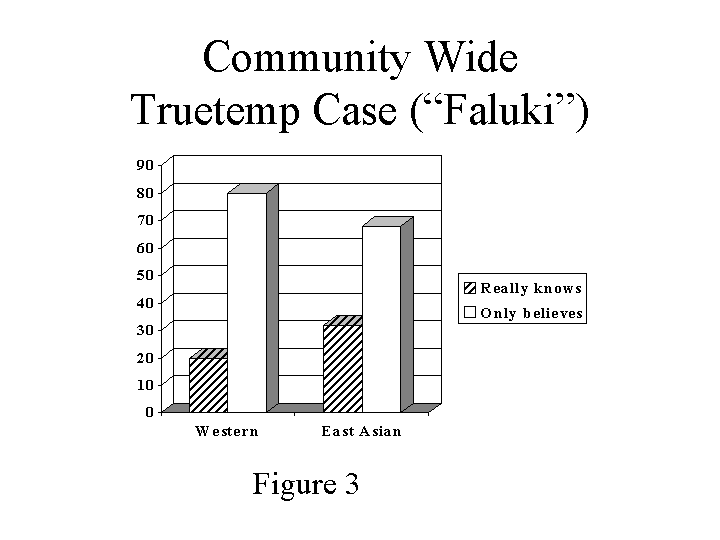
Intriguingly,
though the difference is not statistically significant, the percentage
of EAs who answered “Really Knows” in this case was greater than
the percentage of Ws who gave that
answer, reversing the pattern in the individualistic “hit by a rock” case. Figure
4, which is a comparison of the three Truetemp cases, illustrates the way
in which the large difference between Ws and EAs in the Individualistic
version disappears in the Elders version and looks to be reversing direction
in the Faluki version.

3.3.2.Gettier
Cases
A
category of examples that has loomed large in the recent epistemology literature
are “Gettier cases”, in which a person has good (though, as it happens,
false, or only accidentally true, or in some other way warrant–deprived)
evidence for a belief which is true. These
cases are, of course, by their very construction in many ways quite similar
to unproblematic cases in which a person has good and true evidence for
a true belief. As Norenzayan and
Nisbett have shown, EAs are more inclined than Ws to make categorical judgments
on the basis of similarity. Ws, on
the other hand, are more disposed to focus on causation in describing the
world and classifying things.[28]In
a large class of Gettier cases, the evidence that causes the target
to form a belief turns out to be false. This suggest that EAs might be
much less inclined than Ws to withhold the attribution of knowledge in
Gettier cases. And, indeed, they
are.
The
intuition probe we used to explore cultural differences on Gettier cases
was the following:
Bob
has a friend, Jill, who has driven a Buick for many years. Bob
therefore thinks that Jill drives an American car.He
is not aware, however, that her Buick has recently been stolen, and he
is also not aware that Jill has replaced it with a Pontiac, which is a
different kind of American car. Does
Bob really know that Jill drives an American car, or does he only believe
it?
REALLY
KNOWS ONLY BELIEVES
The
striking finding in this case is that a large majority of Ws give the standard
answer in the philosophical literature, viz. “Only Believes.” But
amongst EAs this pattern is actually reversed! A
majority of EAs say that Bob really knows. The results are shown in Figure
5.
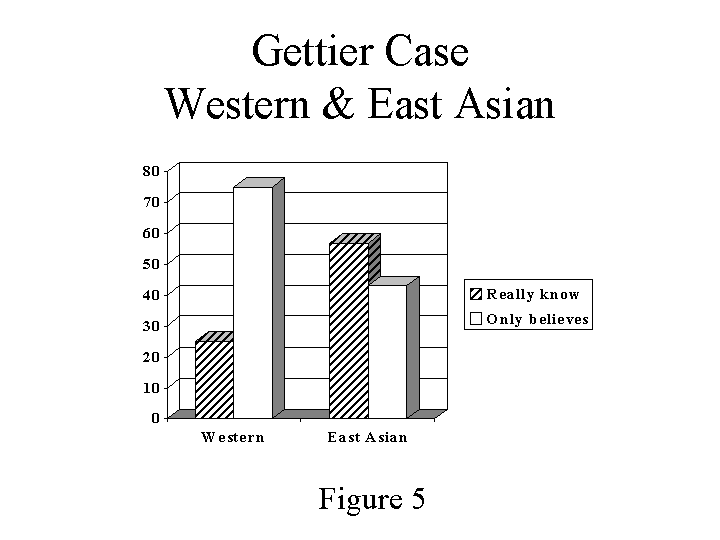
3.3.3.
Evidence from Another Ethnic Group
The
experiments we have reported thus far were done in lower division classes
and large lectures at Rutgers. Since
Rutgers is the State University of New Jersey and New Jersey is home to
many people of Indian, Pakistani and Bangladeshi descent, in the course
of the experiments we collected lots of data about these people’s intuitions. Initially
we simply set these data aside since we had no theoretical basis for expecting
that the epistemic intuitions of people from the Indian sub–continent (hereafter
SCs) would be systematically different from the epistemic intuitions of
Westerners. But, after finding the
extraordinary differences between Ws and EAs on the Gettier case, we thought
it might be interesting to analyze the SC data as well. We
were right. It turns out that the
epistemic intuitions of SCs are even more different from the intuitions
of Ws than the intuitions of EAs are. The
SC results on the Gettier case are shown in Figure 6.If
these results are robust, then it seems that what counts as knowledge on
the banks of the Ganges does not count as knowledge on the banks of the
Mississippi!

There
were two additional intuition probes that we used in our initial experiments
which did not yield statistically significant differences between Ws and
EAs. But when we analyzed the SC
data, it turned out that there were significant differences between Ws
and SCs. The text for one of these
probes, the Cancer Conspiracy case, was
as follows:
It’s
clear that smoking cigarettes increases the likelihood of getting cancer. However,
there is now a great deal of evidence that just using nicotine by itself
without smoking (for instance, by taking a nicotine pill) does not increase
the likelihood of getting cancer. Jim
knows about this evidence and as a result, he believes that using nicotine
does not increase the likelihood of getting cancer. It
is possible that the tobacco companies dishonestly made up and publicized
this evidence that using nicotine does not increase the likelihood of cancer,
and that the evidence is really
false and misleading. Now, the tobacco
companies did not actually make up this evidence, but Jim is not aware
of this fact. Does Jim really know
that using nicotine doesn’t increase the likelihood of getting cancer,
or does he only believe it?
REALLY KNOWS ONLY
BELIEVES
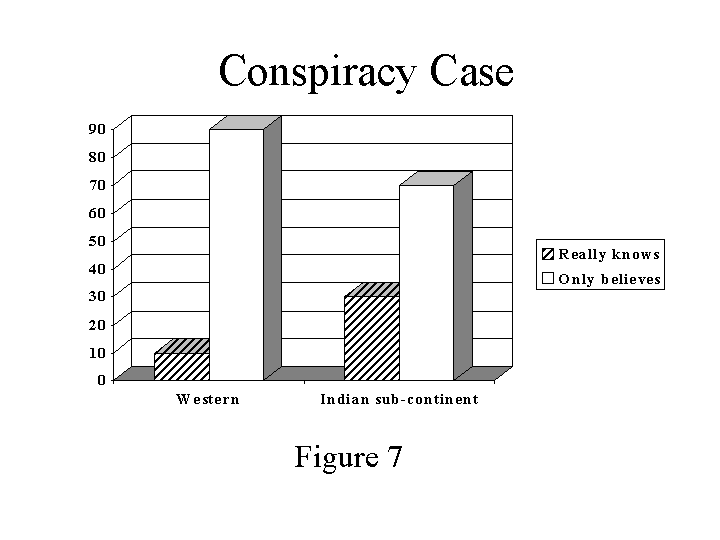
The
other probe that produced significant differences is a version of Dretske’s
Zebra-in-Zoo
case (Dretske, 1970):
Mike
is a young man visiting the zoo with his son, and when they come to the
zebra cage, Mike points to the animal and says, “that’s a zebra.” Mike
is right –– it is a zebra. However,
as the older people in his community know, there are lots of ways that
people can be tricked into believing things that aren’t true. Indeed,
the older people in the community know that it’s possible that zoo authorities
could cleverly disguise mules to look just like zebras, and people viewing
the animals would not be able to tell the difference. If
the animal that Mike called a zebra had really been such a cleverly painted
mule, Mike still would have thought that it was a zebra. Does
Mike really know that the animal is a zebra, or does he only believe that
it is?
REALLY
KNOWS
ONLY BELIEVES
The
results are shown in Figure 8.
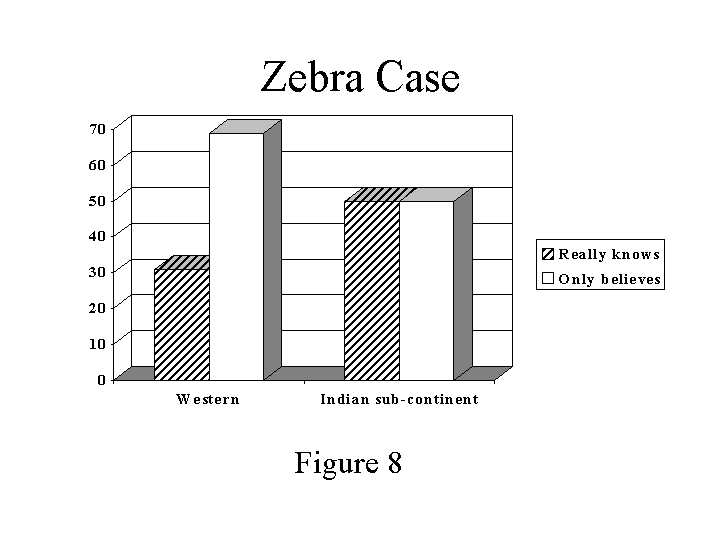
What’s
going on in these last two cases? Why
do SCs and Ws have different epistemic intuitions about them. The
answer, to be quite frank, is that we are not sure how to explain these
results. But, of course, for our
polemical purposes, an explanatory hypothesis is not really essential.
The mere fact that Ws, EAs and SCs have different epistemic intuitions
is enough to make it plausible that IDR strategies which take these intuitions
as inputs would yield significantly different normative pronouncements
as output. And this, we think, puts
the ball squarely in the court of the defenders of IDR strategies. They
must either argue that intuitive differences of the sort we’ve found would
not lead to diverging normative claims, or they must argue that the outputs
of an IDR strategy are genuinely normative despite the fact that they are
different for different cultures. Nor is this the end of the bad news for
those who advocate IDR strategies.
3.3.4.Epistemic
Intuitions and Socioeconomic Status
Encouraged
by our findings in these cross–cultural studies, we have begun to explore
the possibility that epistemic intuitions might also be sensitive to the
socioeconomic status of the people offering the intuitions. And
while our findings here are also quite preliminary, the apparent answer
is that SES does indeed have a major impact on subjects’ epistemic intuitions.
Following
Haidt (and much other research in social psychology) we used years of education
to distinguish low and high SES groups. In
the studies we will recount in this section, subjects were classified as
low SES if they reported that they had never attended college. Subjects
who reported that they had one or more years of college were coded as high
SES. All the subjects were adults;
they were approached near various commercial venues in downtown New Brunswick,
New Jersey, and (since folks approached on the street tend to be rather
less compliant than university undergraduates in classrooms) they were
offered McDonald’s gift certificates worth a few dollars if they agreed
to participate in our study.
Interestingly,
the two intuition probes for which we found significant SES differences
both required the subjects to assess the importance of possible states
of affairs that do not actually obtain. Here
is the first probe, which is similar to the Dretske–type case discussed
above:
Pat
is at the zoo with his son, and when they come to the zebra cage, Pat points
to the animal and says, “that’s a zebra.” Pat is right –– it is a zebra.
However, given the distance the spectators are from the cage, Pat would
not be able to tell the difference between a real zebra and a mule that
is cleverly disguised to look like a zebra. And if the animal had really
been a cleverly disguised mule, Pat still would have thought that it was
a zebra. Does Pat really know that the animal is a zebra, or does he only
believe that it is?
REALLY KNOWS ONLY
BELIEVES
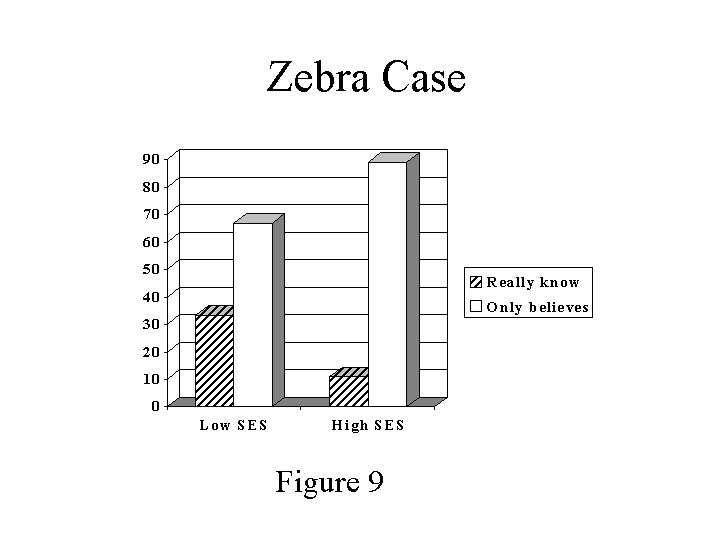
The
second probe that produced significant (indeed enormous) differences between
our two SES groups was the Cancer Conspiracy case that also generated differences
between Western subjects and subjects from the Indian sub–continent. The
results are shown in Figure 10. (For the text see 3.3.3.)
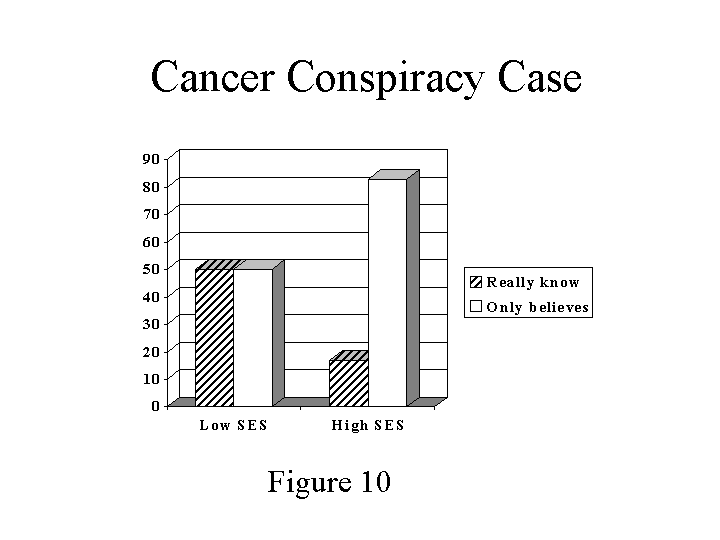
Why
are the intuitions in these two SES groups so different? Here again we
do not have a well worked out theoretical framework of the sort that Nisbett
and his colleagues have provided for the W vs. EA differences. So
any answer we offer is only a speculation. One
hypothesis is that one of the many factors that subjects are sensitive
to in forming epistemic intuitions of this sort is the extent to which
possible but non-actual states of affairs are relevant. Another possibility
is that high SES subjects accept much weaker knowledge-defeaters than low
SES subjects because low SES subjects have lower minimum standards for
knowledge. More research is needed
to determine whether either of these conjectures is correct. But
whatever the explanation turns out to be, the data we’ve reported look
to be yet another serious embarrassment for the advocates of IDR. As in
the case of cultural difference, they must either argue that these intuitive
differences, when plugged into an IDR black box, would not lead to different
normative conclusions, or they must bite the bullet and argue that diverging
normative claims are genuinely normative, and thus that the sorts of doxastic
states that ought to be pursued by relatively rich and well educated people
are significantly different from the sorts of doxastic states that poor
and less well educated folks should seek. We
don’t pretend to have an argument showing that neither of these options
is defensible. But we certainly don’t
envy the predicament of the IDR advocate who has to opt for one or the
other.
4.
Objections and Replies
In
this section we propose to assemble some objections to the case against
IDR that we’ve set out in the preceding sections along with our replies.
4.1.What’s
so bad about epistemic relativism?
Objection:
Suppose
we’re right. Suppose that epistemic
intuitions do differ in different ethnic and SES groups, and that
because of this IDR strategies will generate different normative conclusions
depending on which group uses them. Why,
the critic asks, should this be considered a problem for IDR advocates? At
most it shows that different epistemic norms apply to different groups,
and thus that epistemic relativism is true. But
why, exactly, is that a problem? What’s
so bad about epistemic relativism? “Indeed,”
we imagine the critic ending with an ad hominem flourish, “one of
the authors of this paper has published a book that defends epistemic
relativism.”[29]
Reply:
We
certainly have no argument that could show that all forms of epistemic
relativism are unacceptable, and the one avowed relativist among us is
still prepared to defend some forms of relativism.But
if we are right about epistemic intuitions, then the version of relativism
to which IDR strategies lead would entail that the epistemic norms appropriate
for the rich are quite different from the epistemic norms appropriate for
the poor, and that the epistemic norms appropriate for white people are
different from the norms appropriate for people of color.[30]And
that we take to be quite a preposterous result.The
fact that IDR strategies lead to this result is, we think, a very strong
reason to think that there is something very wrong with those strategies.Of
course, a defender of an IDR strategy might simply bite the bullet, and
insist that the strategy he or she advocates is the right one for uncovering
genuine epistemic norms, despite the fact that it leads to a relativistic
consequence that many find implausible.But
the IDR advocate who responds to our data in this way surely must offer
some argument for the claim that the preferred IDR strategy produces
genuine epistemic norms.And we
know of no arguments along these lines that are even remotely plausible.
4.2.There
are several senses of ‘knowledge’
Objection:
The
next objection begins with the observation that epistemologists have long
been aware that the word ‘knows’ has more than one meaning in ordinary
discourse. Sometimes when people
say that they “know” that something is the case, what they mean is that
they have a strong sense of subjective certainty. So,
for example, someone at a horse race might give voice to a strong hunch
by saying: “I just know that Ivory Armchair is going to win.”And
even after Lab Bench comes in first, this colloquial sense of ‘know’ still
permits them to say, “Drat!I just
knew that Ivory Armchair was going to win.” At
other times, though, when people use ‘know’ and ‘knowledge’ the sense they
have in mind is the one that is of interest to epistemologists. The
problem with our results, this objection maintains, is that we did nothing
to ensure that when subjects answered “Really Know” rather than “Only Believe”
the sense of ‘know’ that they had in mind was the one of philosophical
interest rather then the subjective certainty sense. “So,”
the critic concludes, “for all you know, your subjects might have been
offering you philosophically uninteresting judgments about people’s sense
of subjective certainty.”
Reply:
It
is certainly possible that some of our subjects were interpreting the “Really
Know” option as a question about subjective certainty. But
there is reason to think that this did not have a major impact on our findings. For
all of our subject groups (W, EA and SC in the ethnic studies and high
and low SES in the SES study) we included a question designed to uncover
any systematic differences in our subjects’ inclination to treat mere subjective
certainty as knowledge. The question
we used was the following:
Dave
likes to play a game with flipping a coin. He sometimes gets a “special
feeling” that the next flip will come out heads. When he gets this “special
feeling”, he is right about half the time, and wrong about half the time.
Just before the next flip, Dave gets that “special feeling”, and the feeling
leads him to believe that the coin will land heads. He flips the coin,
and it does land heads. Did Dave really know that the coin was going to
land heads, or did he only believe it?
REALLY
KNOWS
ONLY BELIEVES
As
shown in Figure 11, there was no difference at all between the high and
low SES groups on this question; in both groups almost none of our subjects
judged that this was a case of knowledge. The
results in the ethnic studies were basically the same.[31]
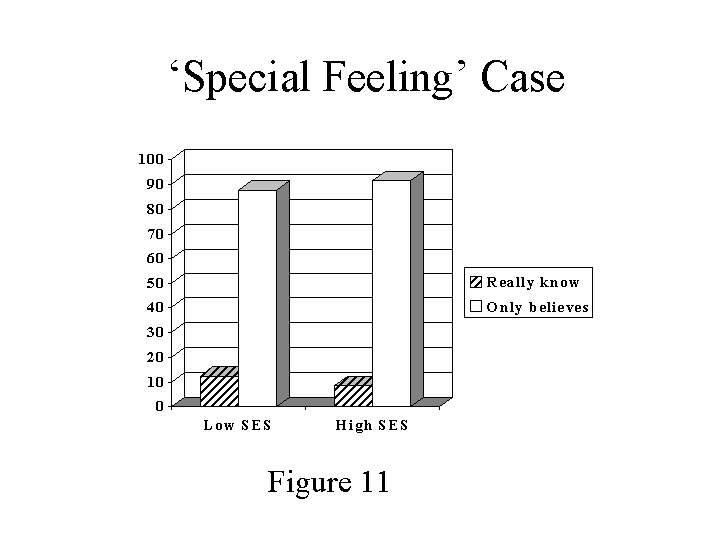
This
might be a good place to elaborate a bit on what we are and are not claiming
about epistemic intuitions and the psychological mechanisms or “knowledge
structures” that may subserve them. For
polemical purposes we have been emphasizing the diversity of epistemic
intuitions in different ethnic and SES groups, since these quite different
intuitions, when plugged into an IDR black box will generate different
normative claims. But we certainly
do not mean to suggest that epistemic intuitions are completely malleable
or that there are no constraints on the sorts of epistemic intuitions that
might be found in different social groups. Indeed,
the fact that subjects from all
the groups we studied agreed in not classifying beliefs based on “special
feelings” as knowledge suggests that there may well be a universal core
to “folk epistemology”. Whether
this conjecture is true and, if it is, how this common core is best characterized,
are questions that will require a great deal more research. Obviously,
these are not issues that can be settled from the philosopher’s armchair.
4.3.The
effect size we’ve found is small and philosophically uninteresting
Objection:
Reply:
Objection:
Reply:
Objection:
Reply:
4.6.We
are looking at the wrong sort of intuitions; the right sort are those that
emerge after an extended period of discussion and reflection
Objection:
Reply:
REFERENCES
Cohen,
L. (1981). “Can human irrationality be experimentally demonstrated?.”
Behavioral and Brain Sciences, 4, 317-370.
Dretske,
F.(1970). “Epistemic Operators.” Journal
of Philosophy, 67(24), 1007-1023.Reprinted
in Dretske, F. (2000) Perception, Knowledge, and Belief. Cambridge,
UK: Cambridge University Press.
Elgin,
C. (1996).Considered Judgment. Princeton,
NJ: Princeton University Press.
Feldman,
R. & Conee E. (1985).“Evidentialism”. Philosophical
Studies, 48, 15-34.
Gettier,
E. (1963).“Is Justified True Belief
Knowledge?” Analysis, 23,
121-123.
Goldman,
A.(1980).“The
Internalist Conception of Justification” in Midwest Studies in Philosophy
V: Epistemology, French, Uehling, and Wettstein eds., Minneapolis:
University of Minnesota Press.
Goldman,
A.(1986).Epistemology
and Cognition. Cambridge, MA: Harvard
University Press.
Goldman,
A.(1992).“Epistemic
Folkways and Scientific Epistemology.” In
Liasons. Cambridge,
MA: MIT Press.
Goldman,
A. and J. Pust.(1998).“Philosophical
Theory and Intuitional Evidence.” In
M. DePaul and W. Ramsey (eds.), Rethinking Intuition. Lanham, Maryland:
Rowman and Littlefield.
Goldman,
A.(1999).“A
Priori Warrant and Naturalistic Epistemology.” In
James Tomberlin (ed.), Philosophical Perspectives (a supplement
to Nous), vol. 13, 1999.
Goodman,
N.(1965).Fact,
Fiction and Forecast. Indianapolis: Bobbs-Merrill.
Haidt,
J., S. Koller & M. Dias (1993).“Affect,
Culture and Morality,” J. of Personality
& Social Psychology, 65, 4, 613-628.
Jackson,
F.(1998).From
Metaphysics to Ethics: A Defence of Conceptual Analysis. Oxford:
Oxford University Press.
Klein,
P. (1999).“Human Knowledge and
the Infinite Regress of Reasons.” Philosophical
Perspectives, 13,
Epistemology, 297-325.
Kvanvig,
J. ed.(1996).Warrant
in Contemporary Epistemology: Essays in Honor of Plantinga’s Theory of
Knowledge. Lanham, MD: Rowman
& Littlefield.
Lehrer,
K. (1990). Theory of Knowledge. Boulder
and London: Westview Press and Routledge.
Lehrer,
K. (1997). Self-Trust: A Study of Reason, Knowledge, and Autonomy. Oxford:
Oxford University Press.
Morris,
M., Nisbett, R., & Peng, K. (1995). “Causal understanding across domains
and cultures,” in D. Sperber, D. Premack, & A. J. Premack (eds.), Causal
Cognition: A Multidisciplinary Debate. Oxford: Oxford University Press.
Nisbett,
R. and Ross, L. (1980). Human Inference: Strategies and Shortcomings
of Social Judgment. Englewood Cliffs, NJ: Prentice-Hall.
Nisbett,
R., Peng, K., Choi, I. and Norenzayan, A. (in press). Culture and Systems
of Thought: Holistic vs. Analytic Cognition. To
appear in Psychological Review.?
Norenzayan,
A., Nisbett, R. E., Smith, E. E., & Kim, B. J. (1999). Rules vs.
similarity as a basis for reasoning and judgment in East and West .
Ann Arbor: University of Michigan.
Plantinga,
A.(1993a).Warrant:
The Current Debate. Oxford: Oxford
University Press.
Plantinga,
A.(1993b).Warrant
and Proper Function. Oxford:
Oxford University Press.
Plato
(1892/1937).The Dialogues of
Plato translated by B. Jowett. New
York: Random House.
Pollock,
J. & Cruz, J.(1999).Contemporary
Theories of Knowledge. Lanham,
MA: Rowman & Littlefield Publishers.
Samuels,
R.(in preparation). “Naturalism
and Normativity.”
Samuels,
R, Stich, S. & Faucher, L. (in press). “Reasoning
and Rationality,” in Handbook of Epistemology ed. by I. Niiniluoto,
M. Sintonen, & J. Wolenski. Dordrecht:
Kluwer.
Samuels,
R., Stich, S.&Tremoulet,
P. (1999).“Rethinking Rationality: From
Bleak Implications to Darwinian Modules,” in What Is Cognitive Science?
ed.
by E. LePore & Z. Pylyshyn. Oxford:
Blackwells. Pp. 74-120.
Samuels,
R., Stich, S.& Bishop, M. (in
press). “Ending the Rationality Wars: How
to Make Disputes About Human Rationality Disappear,” in Renee Elio, ed.,
Common
Sense, Reasoning and Rationality, Vancouver
Studies in Cognitive Science, vol.
11. Oxford: Oxford University Press.
Shope,
R.(1983).The
Analysis of Knowing. Princeton,
NJ: Princeton University Press.
Sosa,
E.(1991).Knowledge
in Perspective. Cambridge: Cambridge
University Press.
Sosa,
E. ed.(1994).Knowledge
and Justification. Brookfield,
VT: International Research Library of Philosophy, Dartmouth Publishing
Company Limited.
Stein,
E.(1996).Without
Good Reason: The Rationality Debate
in Philosophy and Cognitive Science. Oxford:
Clarendon Press.
Stich,
S.(1990).The
Fragmentation of Reason. Cambridge,
MA: MIT Press.
Watanabe,
M. (1998).“Styles of reasoning
in Japan and the United States: Logic of Education in two cultures.” Paper
presented at the American Sociological Association Annual Meeting, San
Francisco, August, 1998.
Watanabe,
M. (1999).Styles of reasoning
in Japan and the United States: Logic of education in two cultures.
Unpublished Ph.D. thesis, Columbia University.
APPENDIX
|
|
Really
knows
|
Only
believes
|
|
Western
|
61
|
128
|
|
East
Asian
|
3
|
22
|
The
p-exact = 0.020114
|
|
Really
knows
|
Only
believes
|
|
Western
|
77
|
140
|
|
East
Asian
|
5
|
15
|
The
p-exact= 0.131784
|
|
Really
knows
|
Only
believes
|
|
Western
|
2
|
8
|
|
East
Asian
|
10
|
21
|
The
p-exact= 0.252681
Gettier
Case: Western & East Asian (Figure 5)
|
|
Really
knows
|
Only
believes
|
|
Western
|
17
|
49
|
|
East
Asian
|
13
|
10
|
The
p-exact= 0.006414
|
|
Really
knows
|
Only
believes
|
|
Western
|
17
|
49
|
|
Indian
subcontinental
|
14
|
9
|
The
p-exact= 0.002407
|
|
Really
knows
|
Only
believes
|
|
Western
|
7
|
59
|
|
Indian
subcontinental
|
7
|
16
|
The
p-exact= 0.025014
|
|
Really
knows
|
Only
believes
|
|
Western
|
19
|
43
|
|
Indian
subcontinental
|
12
|
12
|
The
p-exact= 0.049898
|
|
Really
knows
|
Only
believes
|
|
Low
SES
|
8
|
16
|
|
High
SES
|
4
|
30
|
The
p-exact= 0.038246
|
|
Really
knows
|
Only
believes
|
|
Low
SES
|
12
|
12
|
|
High
SES
|
6
|
29
|
The
p-exact= 0.006778
|
|
Really
knows
|
Only
believes
|
|
Low
SES
|
3
|
32
|
|
High
SES
|
3
|
21
|
The
p-exact= 0.294004
Special Feeling
Case:Western & East Asian (no
figure)
|
|
Really
knows
|
Only
believes
|
|
Western
|
2
|
59
|
|
East
Asian
|
0
|
8
|
The
p-exact= 0.780051